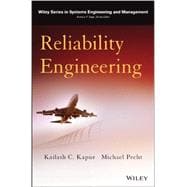Reliability Engineering presents an integrated approach to the design, engineering, and management of reliability activities throughout the life cycle of a product, including concept, research and development, design, manufacturing, assembly, sales, and service. Containing illustrative guides that include worked problems, numerical examples, homework problems, a solutions manual, and class-tested materials, it demonstrates to product development and manufacturing professionals how to distribute key reliability practices throughout an organization.
The authors explain how to integrate reliability methods and techniques in the Six Sigma process and Design for Six Sigma (DFSS). They also discuss relationships between warranty and reliability, as well as legal and liability issues. Other topics covered include:
- Reliability engineering in the 21st Century
- Probability life distributions for reliability analysis
- Process control and process capability
- Failure modes, mechanisms, and effects analysis
- Health monitoring and prognostics
- Reliability tests and reliability estimation
Reliability Engineering provides a comprehensive list of references on the topics covered in each chapter. It is an invaluable resource for those interested in gaining fundamental knowledge of the practical aspects of reliability in design, manufacturing, and testing. In addition, it is useful for implementation and management of reliability programs.








